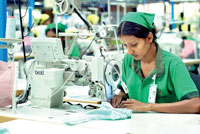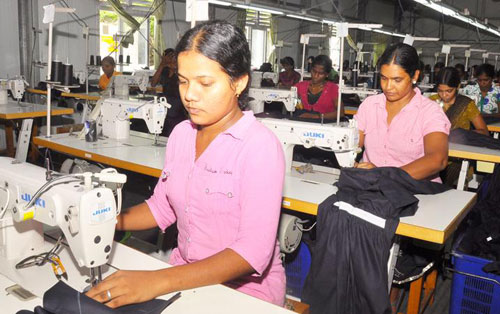 In order to achieve its ambitious target of $8 billion worth of exports by 2025, Sri Lankan apparel sector is looking to first upscale access in emerging markets such as India, China and Brazil. The country will differentiate its products with quality standards and excellent product delivery to capture global demand. The apparel industry, which contributes 7 per cent of GDP (Gross Domestic Product) and 53 per cent of export earnings, plans to expand its operations to South Asian countries such as India and China and to South America. Apparel exports, last year, grew by 5 per cent; while this year it is expected to grow at an annual compound growth rate of over 6 per cent.
In order to achieve its ambitious target of $8 billion worth of exports by 2025, Sri Lankan apparel sector is looking to first upscale access in emerging markets such as India, China and Brazil. The country will differentiate its products with quality standards and excellent product delivery to capture global demand. The apparel industry, which contributes 7 per cent of GDP (Gross Domestic Product) and 53 per cent of export earnings, plans to expand its operations to South Asian countries such as India and China and to South America. Apparel exports, last year, grew by 5 per cent; while this year it is expected to grow at an annual compound growth rate of over 6 per cent.
Exports subject to tariff rules
Around 12 per cent of Indian apparel exports are shipped to other continents. The countries for exports are determined on the basis of the tariff and country of origin rules. Earlier bilateral agreements were the exception to the rule but now World Trade Organisation (WTO) regulations has become the exception while bilateral agreements are the rule.
determined on the basis of the tariff and country of origin rules. Earlier bilateral agreements were the exception to the rule but now World Trade Organisation (WTO) regulations has become the exception while bilateral agreements are the rule.
A standard rule that the apparel industry follows is the double transformation principle which involves converting fiber into yarn, yarn into fabric and fabric into garments. This theory helps countries such as India, Indonesia and Thailand, where vertical integration is very high.
Issues faced by the Sri Lankan apparel sector
Sri Lanka, as a nation does not recognise the value of apparel exports as much. The sector contributes to the economy on its own efforts. Government support in terms of facilities and recognition will attract more industrialists to the nation besides ensuring skilled labour in the workforce.
The SME sector within the apparel sector faces labor issues. As this sector fails to attract youth, it faces acute scarcity of labor. Besides, the present level of the trade reforms agenda lacks forward looking policies which makes it extremely difficult for the industry to maintain its growth momentum.
Government initiatives to boost growth
Though the industry has still not stabilised, this year’s budget provides enhanced capital for expanding a company. The government is also trying to improve the availability of credit, skills and finances. However, these efforts will prove beneficial only in the longer run. The industry needs to be controlled and maintained on a systematic basis. It should be organised so as to enable buying continuously or promote concepts such as rentals.
Before 2005, there was no competition among countries for apparel as the industry did not offer its buyers the freedom to plan their purchases. However, this system liberalised post 2005 enabling all countries to enter into the business. Sri Lanka, which already faces difficulties such as unavailability of fabric and scarcity of labour, needs to differentiate itself through quality and value added services. The sector has already negotiated with the government for minimising transactions with state agencies mainly with regard to apparel exports. It has also requested the government to make all documentation processes available online, thus reducing human intervention.
The sector has also requested the government to recognise digital signatures and online transactions. It is also negotiating with the Sri Lanka Customs to automate the verification processes to clear the goods quickly. These methods will quicken the will not only quicken the delivery process but also improve its efficiency.












